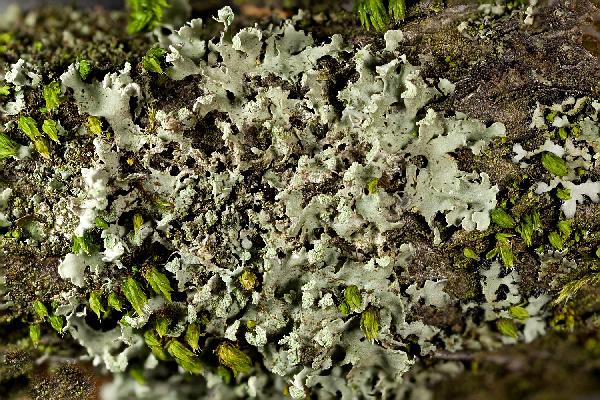Physciella chloantha (Ach.) Essl.
Mycologia, 78: 94, 1986. Basionym: Parmelia chloantha Ach. - Syn. Meth. Lich.: 217, 1814.
Synonyms: Phaeophyscia chloantha (Ach.) Moberg; Physcia labrata var. intermedia Mereschk.; Physcia luganensis Mereschk.; Physcia obscura var. chloantha (Ach.) Rabenh.; Physcia pragensis Nádv.
Distribution: N - VG (Castello 1996, 2002, Carvalho 1997, Martellos & Castello 2004, Castello & Skert 2005, Tretiach & al. 2007b), Frl (Badin & Nimis 1996, Nimis & Salvadori 1997, Castello & Skert 2005, Tretiach & Molaro 2007, Nascimbene & Salvadori 2008, Nascimbene & al. 2009b, Bernini & al. 2010), Ven (Nascimbene 2005c, 2008, Nascimbene & Salvadori 2008, Nascimbene & al. 2008e, 2015, Nascimbene & Marini 2010), TAA (De Benetti & Caniglia 1993, Nascimbene 2005b, 2006c, 2014, Nascimbene & al. 2007b, 2014, 2022, Zarabska & al. 2009, Nimis & al. 2015), Lomb (Rivellini 1994, Arosio & Rinaldi 1995, Zocchi & al. 1997, Brusa 1998, Arosio & al. 2000, 2003, Anderi & al. 2005, Valcuvia & Truzzi 2007b, Gheza & al. 2015, Gheza 2019b), Piem (Caniglia & al. 1992, Arosio & al. 1998, Piervittori 1998, 2003, Clerc & al. 1999, Castino 2004, Isocrono & al. 2004, 2005b, 2007, Griselli & al. 2003, Isocrono & Piervittori 2008, Furlanetto 2010, Matteucci & al. 2010), VA (Piervittori & Isocrono 1999, Valcuvia & al. 2000b), Emil (Bassi 1995, Gasparo & Tretiach 1996, Nimis & al. 1996, Sallese 2003, Morselli & Regazzi 2006, Tretiach & al. 2008, Fariselli & al. 2020), Lig (Giordani & Brunialti 2000, Giordani & al. 2002, 2025, Giordani & Incerti 2008). C - Tosc (Loppi & al. 1997c, 2002, 2002b, 2002c, 2003, 2004, 2006, Lorenzini & al. 2003, Loppi & Corsini 2003, Loppi & Frati 2006, Paoli & Loppi 2008, Brunialti & Frati 2010, Loppi & Nascimbene 2010, Nascimbene & al. 2015, Frati & Brunialti 2023, Fačkovcová & al. 2024), Marc (Frati & al. 2004, Frati & Brunialti 2006), Umb (Ravera 2000, Ravera & al. 2006, Ciotti & al. 2009, Paoli & al. 2012), Laz (Gigante & Petriccione 1995, Ravera & al. 1999, Massari & Ravera 2002, Nimis & Tretiach 2004, Ruisi & al. 2005, Munzi & al. 2007, Ravera 2008b, Ravera & Genovesi 2008), Abr (Recchia & al. 1993, Caporale & al. 2016), Mol (Frati & al. 2004, Caporale & al. 2008, Ravera & al. 2010, Paoli & al. 2011, 2015, Caporale & Ravera 2020), Sar (Rizzi & al. 2011, Di Nuzzo & al. 2022). S - Camp, Pugl (Nimis & Tretiach 1999), Bas (Nimis & Tretiach 1999, Paoli & al. 2006), Cal (Puntillo 1996, Incerti & Nimis 2006), Si (Nimis & al. 1996b, Ravera & al. 2023b).
Description: Thallus foliose, heteromerous, dorsiventral, narrow-lobed, rather loosely attached, forming at first orbicular, then irregular, up to 3 cm wide rosettes. Lobes discrete to imbricate, (0.2-)0.5-1(-1.5) mm broad, flat, whitish to pale brown, epruinose, with terminal labriform soralia at the tips of ascending lobules. Lower surface white to pale tan, with simple, pale rhizines. Upper cortex paraplectenchymatous; medulla white; lower cortex prosoplectenchymatous. Apothecia very rare, lecanorine. Asci 8-spored, clavate, the K/I+ blue tholus penetrated by a faintly amyloid apical cushion with parallel or diverging flanks, the wall K/I-, surrounded by a K/I+ blue outer layer, Lecanora-type. Ascospores 1-septate, brown, ellipsoid, 17-23 x 8-11 µm, the wall thickened at apex and at septum, Physcia-type. Pycnidia rare. Conidia short-ellipsoid. Photobiont chlorococcoid. Spot tests: cortex and medulla K-, C-, KC-, P-, UV-. Chemistry: without lichen substances. Note: a mild-temperate, typically submediterranean species occurring on a wide range of substrata (mostly on bark of isolated trees, but also on limestone in open woodlands), but never common in heavily disturbed habitats, rare along the eastern side of the Peninsula. It could be confused with specimens pf Phaeophyscia endophoenicea with a white medulla, which however, have a black lower surface.
Growth form: Foliose, narrow lobed
Substrata: bark and rocks
Photobiont: green algae other than Trentepohlia
Reproductive strategy: mainly asexual, by soredia, or soredia-like structures (e.g. blastidia)
Commonnes-rarity: (info)
Alpine belt: absent
Subalpine belt: absent
Oromediterranean belt: absent
Montane belt: extremely rare
Submediterranean belt: rather rare
Padanian area: extremely rare
Humid submediterranean belt: rather rare
Humid mediterranean belt: very rare
Dry mediterranean belt: absent
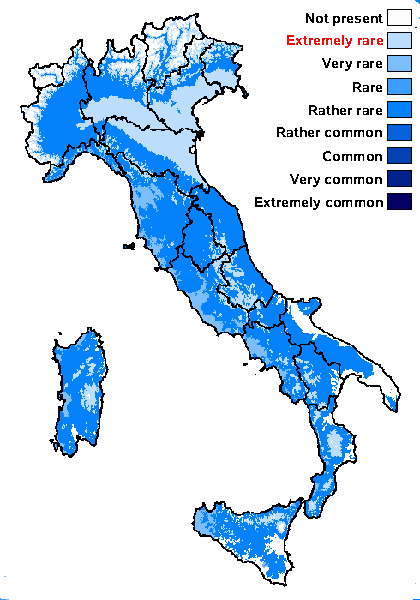
Predictive model
Herbarium samples
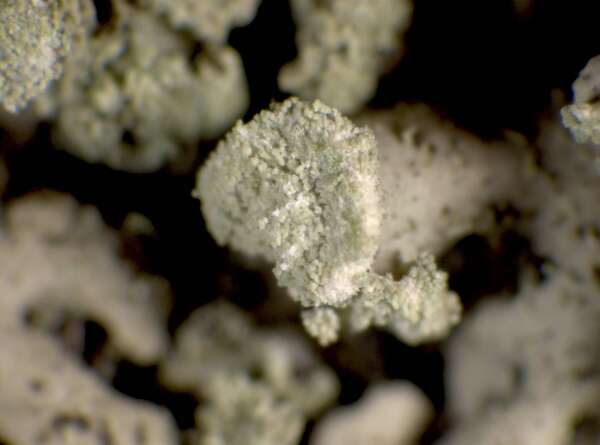

P.L. Nimis; Owner: Department of Life Sciences, University of Trieste
Herbarium: TSB (31391)
2001/12/05
detail of soralium
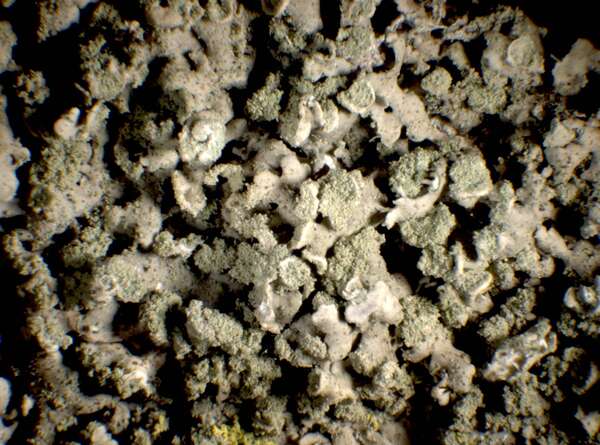

P.L. Nimis; Owner: Department of Life Sciences, University of Trieste
Herbarium: TSB (31391)
2001/12/05


Juri Nascimbene; Owner: Department of Life Sciences, University of Trieste
Italy, Trentino-Alto Adige, Trento, Villa Welsperg, Centro Visitatori del Parco di Paneveggio; altitude: 1030 m
03.04.2009
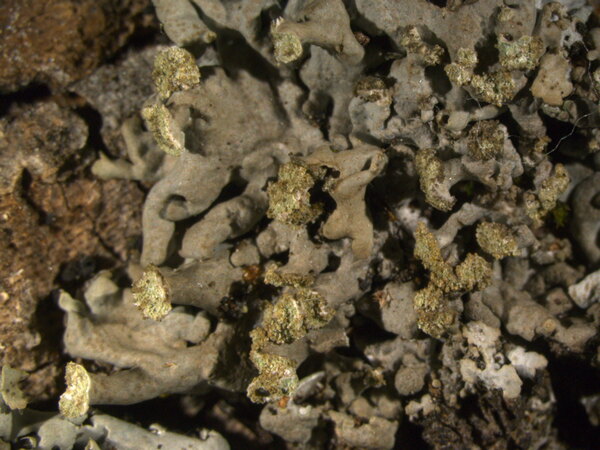

Juri Nascimbene; Owner: Department of Life Sciences, University of Trieste
Italy, Trentino-Alto Adige, Trento, Villa Welsperg, Centro Visitatori del Parco di Paneveggio; altitude: 1030 m
03.04.2009
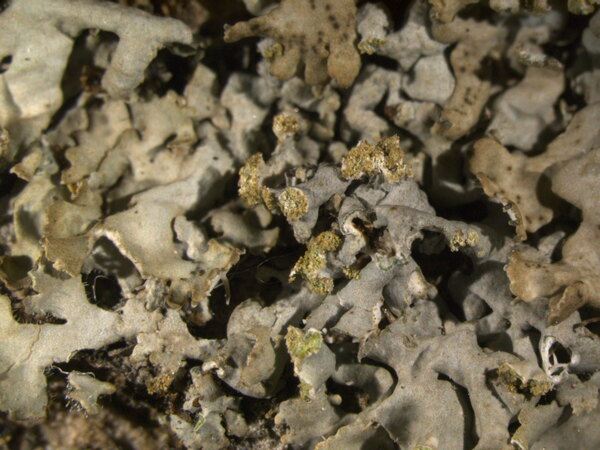

Juri Nascimbene; Owner: Department of Life Sciences, University of Trieste
Italy, Trentino-Alto Adige, Trento, Villa Welsperg, Centro Visitatori del Parco di Paneveggio; altitude: 1030 m
03.04.2009
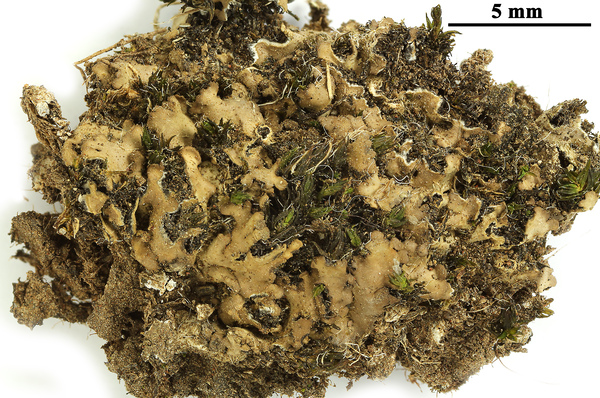

Felix Schumm - CC BY.SA 4.0
[14097], Portugal, Azoren, Terceira, bei Sao Bartholomeu 38°40.482' N, 27°17.586' W, 125 m. Leg. A. Aptroot & F. Schumm, 13.07.2008, det. A. Aptroot.
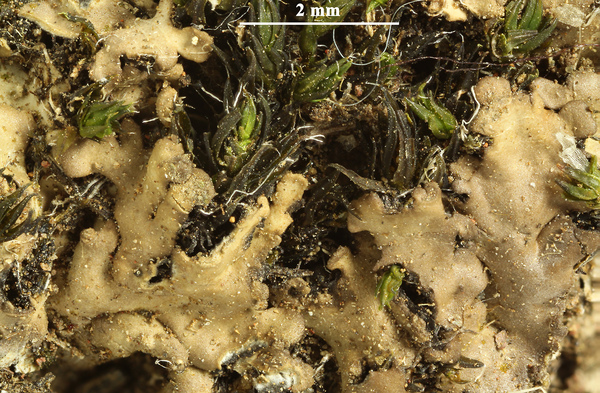

Felix Schumm - CC BY.SA 4.0
[14097], Portugal, Azoren, Terceira, bei Sao Bartholomeu 38°40.482' N, 27°17.586' W, 125 m. Leg. A. Aptroot & F. Schumm, 13.07.2008, det. A. Aptroot.
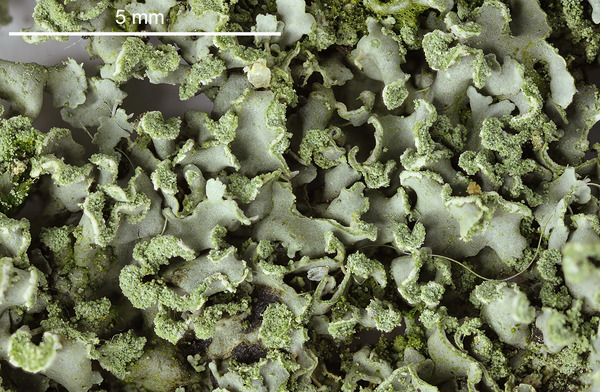

Felix Schumm – CC BY-SA 4.0
[14957], Germany, Baden-Württemberg, Kreis Göppingen, Faurndau, auf Sandsteinmauer der Faurndauer Kirche, 48,70290° N, 9,61455° E, 314 m, 314 m. Leg. F. Schumm & A. Aptroot, 18.09.2009, det. A. Aptroot.
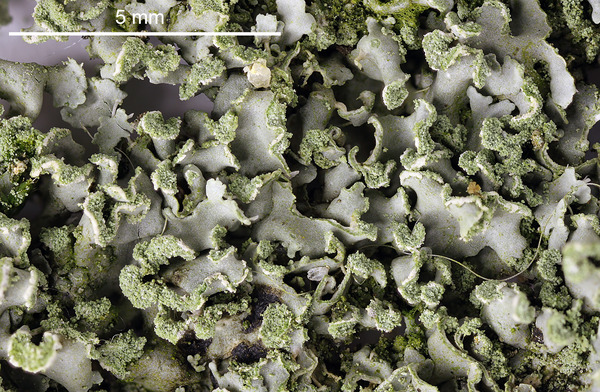

Felix Schumm – CC BY-SA 4.0
[14957], Germany, Baden-Württemberg, Kreis Göppingen, Faurndau, auf Sandsteinmauer der Faurndauer Kirche, 48,70290° N, 9,61455° E, 314 m, 314 m. Leg. F. Schumm & A. Aptroot, 18.09.2009, det. A. Aptroot.
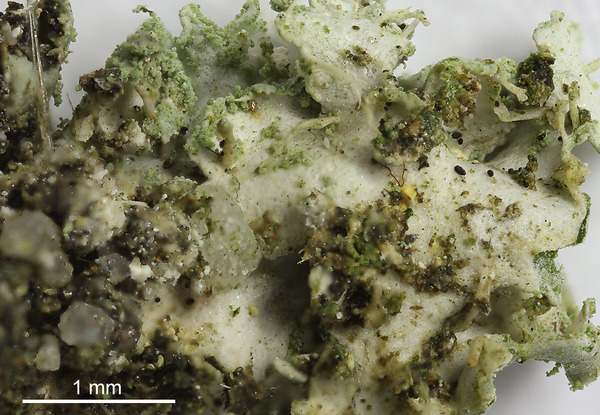

Felix Schumm – CC BY-SA 4.0
[14957], Germany, Baden-Württemberg, Kreis Göppingen, Faurndau, auf Sandsteinmauer der Faurndauer Kirche, 48,70290° N, 9,61455° E, 314 m, 314 m. Leg. F. Schumm & A. Aptroot, 18.09.2009, det. A. Aptroot.


Felix Schumm – CC BY-SA 4.0
[14957], Germany, Baden-Württemberg, Kreis Göppingen, Faurndau, auf Sandsteinmauer der Faurndauer Kirche, 48,70290° N, 9,61455° E, 314 m, 314 m. Leg. F. Schumm & A. Aptroot, 18.09.2009, det. A. Aptroot.
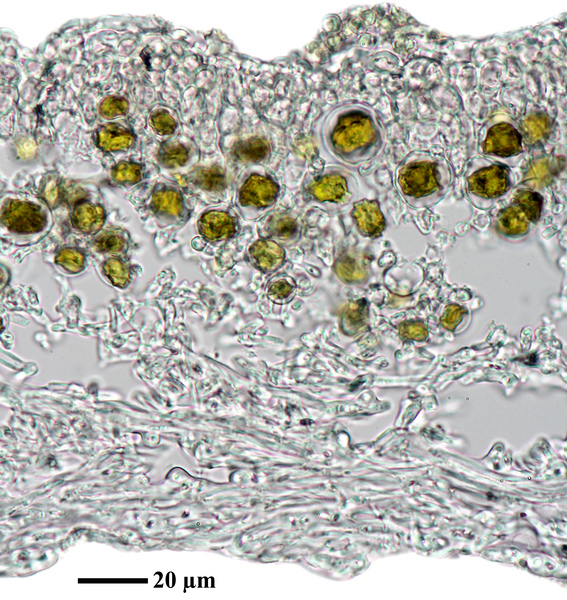

Felix Schumm – CC BY-SA 4.0
[14957], Germany, Baden-Württemberg, Kreis Göppingen, Faurndau, auf Sandsteinmauer der Faurndauer Kirche, 48,70290° N, 9,61455° E, 314 m, 314 m. Leg. F. Schumm & A. Aptroot, 18.09.2009, det. A. Aptroot.
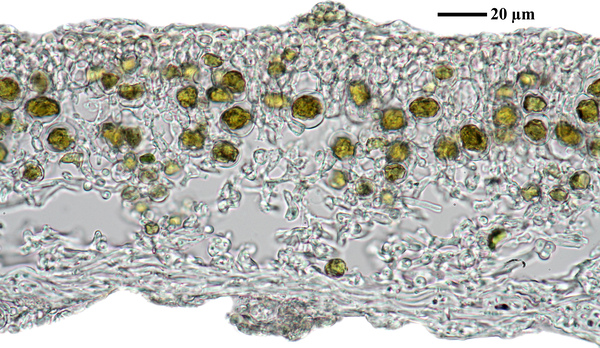

Felix Schumm – CC BY-SA 4.0
[14957], Germany, Baden-Württemberg, Kreis Göppingen, Faurndau, auf Sandsteinmauer der Faurndauer Kirche, 48,70290° N, 9,61455° E, 314 m, 314 m. Leg. F. Schumm & A. Aptroot, 18.09.2009, det. A. Aptroot.
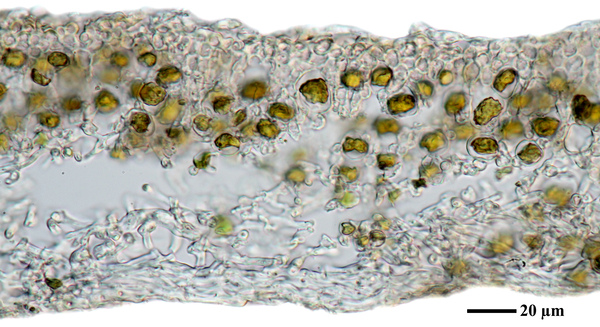

Felix Schumm – CC BY-SA 4.0
[14957], Germany, Baden-Württemberg, Kreis Göppingen, Faurndau, auf Sandsteinmauer der Faurndauer Kirche, 48,70290° N, 9,61455° E, 314 m, 314 m. Leg. F. Schumm & A. Aptroot, 18.09.2009, det. A. Aptroot.


Felix Schumm – CC BY-SA 4.0
[14957], Germany, Baden-Württemberg, Kreis Göppingen, Faurndau, auf Sandsteinmauer der Faurndauer Kirche, 48,70290° N, 9,61455° E, 314 m, 314 m. Leg. F. Schumm & A. Aptroot, 18.09.2009, det. A. Aptroot.
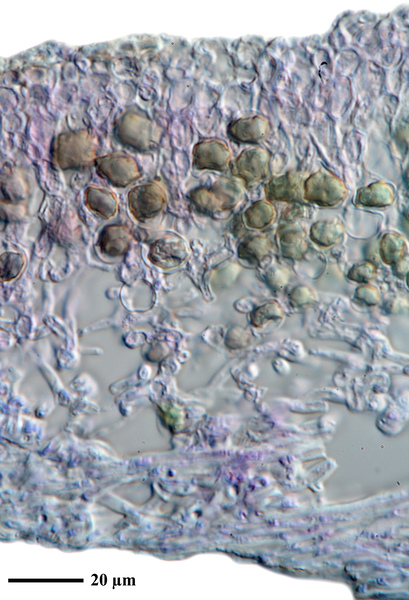

Felix Schumm – CC BY-SA 4.0
[14957], Germany, Baden-Württemberg, Kreis Göppingen, Faurndau, auf Sandsteinmauer der Faurndauer Kirche, 48,70290° N, 9,61455° E, 314 m, 314 m. Leg. F. Schumm & A. Aptroot, 18.09.2009, det. A. Aptroot.
Growth form: Foliose, narrow lobed
Substrata: bark and rocks
Photobiont: green algae other than Trentepohlia
Reproductive strategy: mainly asexual, by soredia, or soredia-like structures (e.g. blastidia)
Commonnes-rarity: (info)
Alpine belt: absent
Subalpine belt: absent
Oromediterranean belt: absent
Montane belt: extremely rare
Submediterranean belt: rather rare
Padanian area: extremely rare
Humid submediterranean belt: rather rare
Humid mediterranean belt: very rare
Dry mediterranean belt: absent

Predictive model
| Herbarium samples |


P.L. Nimis; Owner: Department of Life Sciences, University of Trieste
Herbarium: TSB (31391)
2001/12/05
detail of soralium


P.L. Nimis; Owner: Department of Life Sciences, University of Trieste
Herbarium: TSB (31391)
2001/12/05


Juri Nascimbene; Owner: Department of Life Sciences, University of Trieste
Italy, Trentino-Alto Adige, Trento, Villa Welsperg, Centro Visitatori del Parco di Paneveggio; altitude: 1030 m
03.04.2009


Juri Nascimbene; Owner: Department of Life Sciences, University of Trieste
Italy, Trentino-Alto Adige, Trento, Villa Welsperg, Centro Visitatori del Parco di Paneveggio; altitude: 1030 m
03.04.2009


Juri Nascimbene; Owner: Department of Life Sciences, University of Trieste
Italy, Trentino-Alto Adige, Trento, Villa Welsperg, Centro Visitatori del Parco di Paneveggio; altitude: 1030 m
03.04.2009


Felix Schumm - CC BY.SA 4.0
[14097], Portugal, Azoren, Terceira, bei Sao Bartholomeu 38°40.482' N, 27°17.586' W, 125 m. Leg. A. Aptroot & F. Schumm, 13.07.2008, det. A. Aptroot.


Felix Schumm - CC BY.SA 4.0
[14097], Portugal, Azoren, Terceira, bei Sao Bartholomeu 38°40.482' N, 27°17.586' W, 125 m. Leg. A. Aptroot & F. Schumm, 13.07.2008, det. A. Aptroot.


Felix Schumm – CC BY-SA 4.0
[14957], Germany, Baden-Württemberg, Kreis Göppingen, Faurndau, auf Sandsteinmauer der Faurndauer Kirche, 48,70290° N, 9,61455° E, 314 m, 314 m. Leg. F. Schumm & A. Aptroot, 18.09.2009, det. A. Aptroot.


Felix Schumm – CC BY-SA 4.0
[14957], Germany, Baden-Württemberg, Kreis Göppingen, Faurndau, auf Sandsteinmauer der Faurndauer Kirche, 48,70290° N, 9,61455° E, 314 m, 314 m. Leg. F. Schumm & A. Aptroot, 18.09.2009, det. A. Aptroot.


Felix Schumm – CC BY-SA 4.0
[14957], Germany, Baden-Württemberg, Kreis Göppingen, Faurndau, auf Sandsteinmauer der Faurndauer Kirche, 48,70290° N, 9,61455° E, 314 m, 314 m. Leg. F. Schumm & A. Aptroot, 18.09.2009, det. A. Aptroot.


Felix Schumm – CC BY-SA 4.0
[14957], Germany, Baden-Württemberg, Kreis Göppingen, Faurndau, auf Sandsteinmauer der Faurndauer Kirche, 48,70290° N, 9,61455° E, 314 m, 314 m. Leg. F. Schumm & A. Aptroot, 18.09.2009, det. A. Aptroot.


Felix Schumm – CC BY-SA 4.0
[14957], Germany, Baden-Württemberg, Kreis Göppingen, Faurndau, auf Sandsteinmauer der Faurndauer Kirche, 48,70290° N, 9,61455° E, 314 m, 314 m. Leg. F. Schumm & A. Aptroot, 18.09.2009, det. A. Aptroot.


Felix Schumm – CC BY-SA 4.0
[14957], Germany, Baden-Württemberg, Kreis Göppingen, Faurndau, auf Sandsteinmauer der Faurndauer Kirche, 48,70290° N, 9,61455° E, 314 m, 314 m. Leg. F. Schumm & A. Aptroot, 18.09.2009, det. A. Aptroot.


Felix Schumm – CC BY-SA 4.0
[14957], Germany, Baden-Württemberg, Kreis Göppingen, Faurndau, auf Sandsteinmauer der Faurndauer Kirche, 48,70290° N, 9,61455° E, 314 m, 314 m. Leg. F. Schumm & A. Aptroot, 18.09.2009, det. A. Aptroot.


Felix Schumm – CC BY-SA 4.0
[14957], Germany, Baden-Württemberg, Kreis Göppingen, Faurndau, auf Sandsteinmauer der Faurndauer Kirche, 48,70290° N, 9,61455° E, 314 m, 314 m. Leg. F. Schumm & A. Aptroot, 18.09.2009, det. A. Aptroot.


 INDEX FUNGORUM
INDEX FUNGORUM
 GBIF
GBIF
 DOLICHENS
DOLICHENS
